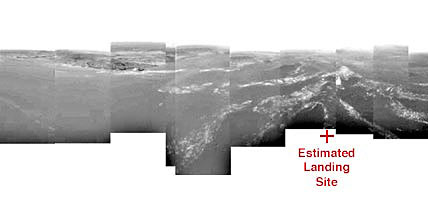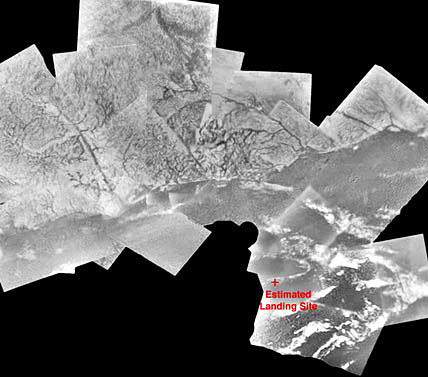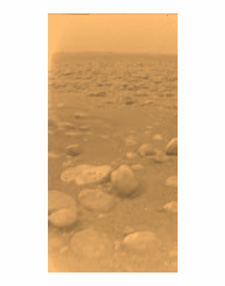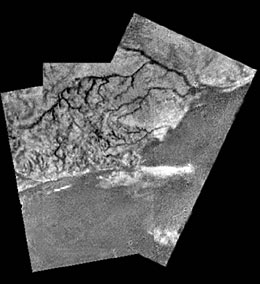
Views from airplane-window height. This is a 360° composite panorama of images taken when Huygens was about 8 kilometers (26,000 feet) above the ground. The river-etched headland and shoreline are at upper left. Light streaks on the dark plain may be pebble deposits and/or ground mists of methane or ethane vapor; suggestively, they run in the direction downwind.
Courtesy ESA / NASA / JPL / University of Arizona.
Saturn's big moon Titan is turning out to be the most Earth-like world in the solar system — except that it is utterly, weirdly, wildly unlike Earth.
Early this morning scientists from the European Space Agency (ESA) held a press conference in Paris to describe the latest findings they have teased out of the data from ESA's Huygens probe. On January 14th, Huygens parachuted through Titan's thick, cloudy atmosphere to a soft landing on a muddy, pebbly floodplain overlooked by icy headlands. The mission succeeded beyond all expectations, with Huygens continuing to transmit for several hours before succumbing to Titan's extreme cold.
"We have lots of evidence for many familiar Earth-like processes of precipitation and erosion and abrasion," summed up Martin G. Tomasko, principal investigator for the Descent Imager-Spectral Radiometer — "Earth-like
processes, if you like, but with very exotic material on this new world."
The weirdness stems from Titan's frigid temperature, which is not far above absolute zero (it was 93°K, –180°C, or –291°F at the landing site), and from an atmospheric chemistry that's almost a mirror image of Earth's. While Earth has an oxidizing atmosphere and very little fuel for our oxygen to burn, Titan has a reducing atmosphere that's loaded with fuel — methane, familiar to us as natural gas — but no oxygen.
The similarity stems from the fact that the temperature is so cold that methane cycles between gas and liquid the same way water does on Earth. So Titan has a "troposphere" with eerily familiar weather: white stormclouds that rain liquified natural gas, which runs off the land in rivers to flow out onto vast, smooth floodplains, where it soaks into the ground and evaporates back to the atmosphere.

As soon as ESA released Huygens' raw images, amateur image processors the world over raced to assemble them into wider views. This downward-looking mosaic showing several kilometers of shoreline was put together by Daniel Crotty using PTAssembler and the GNU Image Manipulation program. An official version has not yet been released by project scientists; it may differ somewhat from this rendition.
Courtesy Daniel Crotty / ESA / NASA / JPL / University of Arizona.
As soon as Huygens descended below Titan's high-altitude smog deck, its images changed from blank views of murk to jaw-dropping snapshots of rugged terrain — with branched channels running to an apparent shoreline, which even shows signs of beaches, on the edge of what looked like a wide, dark sea. Huygens landed a few kilometers "offshore;" the "sea" proved to be bare ground, though still damp with liquid methane just below the surface. The ground right around the lander looked for all the world like a pebbly tide flat on Earth.
Huygens was "extraordinarily lucky," Tomasko said, to descend so close to a border between the bright and dark regions seen from space. Stereo images of the bright headland reveal a ridgeline as much as 100 meters high in a frame 1 kilometer wide, for an average slope of 10 percent (which would be considered a dangerous slope for a road on Earth). But the grade is far from smooth. The uplands are cut almost everywhere by channels with dark-stained bottoms. Tomasko said that rainfall apparently washes dark material off the Titanian "bedrock" — which consists of permanently frozen water ice, not rock — and deposits it on the channel bottoms and the plain.

Titan's surface would look orange if you were there; the dim sunlight filters through high-altitude orange smog. This is a colorized view (all of Huygens' photos are black-and-white). The lumps are probably water ice, Titan's equivalent of rock. The ones in the foreground are roughly fist-size. Note their rounded shapes.
Courtesy ESA / NASA / University of Arizona.
The "dirt" is apparently a mix of ice bits eroded from the land and tarry hydrocarbons that have fallen out of the photochemical smog blanketing the upper atmosphere. The smog is formed by sunlight breaking methane molecules apart. "It's a puzzle why any methane remains," commented Tobias Owen (University of Hawaii). To compensate for the methane loss in the upper atmosphere, Owen said, new methane must still be welling up from Titan's interior. "This is a planet where the liquid is right there," he stressed. "It might have rained yesterday."
ESA scientists term the landing site "muddy." A probe on the bottom of the lander found the soil to be uniformly soft, like wet sand, under a thin crust on top. The lander itself settled about 10 or 15 centimeters (4 or 6 inches) into this material, and the lander's warmth apparently evaporated liquid permeating the soil; sensors detected exhalations of methane gas a few minutes after touchdown.
The rounded "pebbles" on the ground at the lander are probably dirty water ice, shaped by flowing liquid just like pebbles of rock that are rolled in rivers and waves on Earth. On a larger scale, low elevations on the plain appear to have been sculpted by flowing liquid. Dark ovals, said Tomasko, are "pools where the last of the liquid dried up, we think."
Radar has not shown the open seas that planetologists had hoped to find. The hydrology at the site, said Owen, seems more like that of the Arizona desert, "where riverbeds are dry most of the time and the rain sinks below the surface" — except that the "groundwater" under Huygens is just a few centimeters rather than many meters down.

I have reached these lands but newly
From an ultimate dim Thule—
A wild, weird clime that lieth, sublime,
Out of SPACE — out of TIME.
— Edgar Allan Poe, 'Dreamland,' 1844
Courtesy / ESA / NASA / JPL / University of Arizona.
But that's only true right now at this one place. The scientists stressed that Titan may present very different faces elsewhere or at different times (for instance, if the rain is seasonal). But answers may be a long time coming. NASA's Cassini probe, which took seven years to ferry Huygens from Earth to the Saturnian system, will make several flybys of Titan in the coming months and years to fill out infrared and radar maps of Titan's globe. The scientists described the future Titan missions they're already imagining: balloon-borne craft cruising far across the "continents" and "seas," or Mars-like rovers crawling the land. But it will be many years, at the earliest, before we'll ever get another look.
 0
0
Comments
You must be logged in to post a comment.